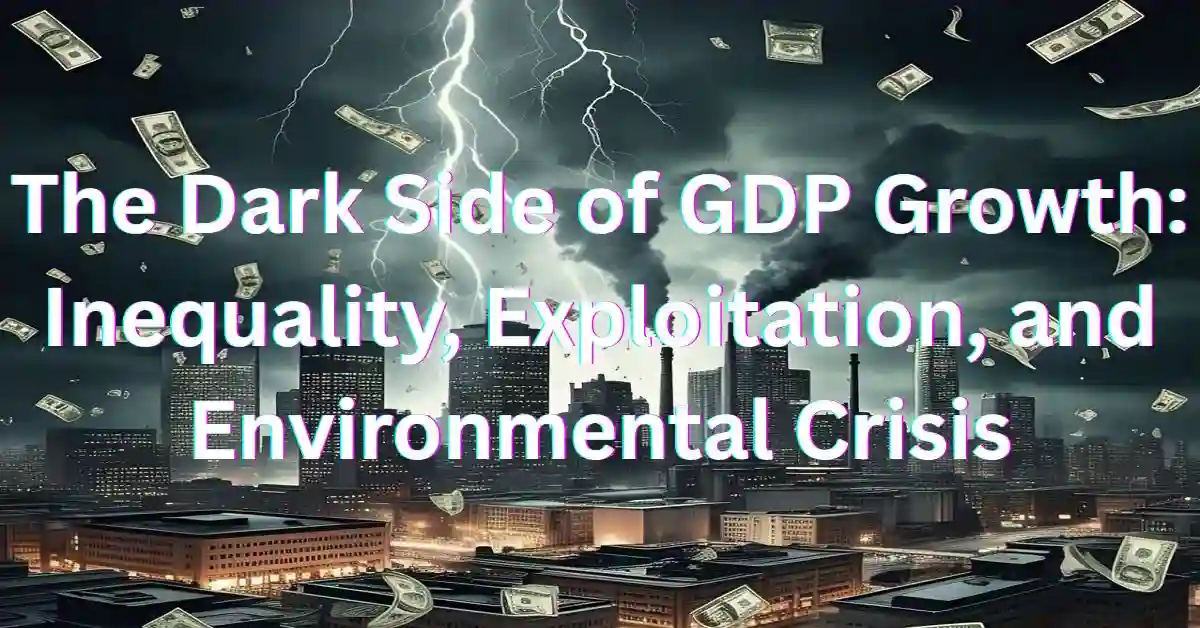In today’s world, Gross Domestic Product (GDP) is commonly viewed as the primary indicator of a country’s economic health. However, the idea that GDP alone tells the full story is misleading. It overlooks important factors like inequality, environmental impact, and overall human well-being. This figure tells us how much a country has produced in terms of goods and services, but does it really reflect the improvement in our lives? Does the growth of GDP benefit all sections of society? In this blog, we will discuss the impacts of GDP, highlighting key issues such as inequality, exploitation, and environmental crises.
1. What is GDP, and Why Is It Not Enough?
GDP measures the total value of goods and services produced in a country. While it gives an idea of how much the economy is growing, it doesn’t show how people’s lives are improving.
- History: GDP was created during the Great Depression in the U.S. to track economic production. It was never meant to measure happiness or quality of life.
- Ignoring Human Realities: GDP ignores important things that don’t involve money, like caregiving and taking care of the environment. A country’s well-being is about more than just how much stuff it produces and consumes. It also includes things like education, health, and people’s happiness.
- Main Problem: The main issue is that GDP can still grow even when inequality rises. This occurs when the wealthiest individuals receive the majority of the benefits from economic growth.
2. The Dark Side of GDP Growth – Inequality and Exploitation
Many economic policies are based on GDP growth as the main indicator of progress. While these policies may lead to an increase in the country’s economic standing, they often result in serious inequality and exploitation within society. Let’s explore why GDP growth often leads to increased inequality and the reasons behind it.
- Inequality in Numbers:
- Mumbai, which houses the largest number of billionaires in Asia, also hosts Dharavi, one of the largest slum settlements in the world. This stark contrast clearly shows that despite GDP growth, its benefits are limited to only certain sections of society.
- Wealth concentrated in the hands of 22 billionaires starkly contrasts with millions living in poverty.
Reasons for Unequal Distribution
When GDP increases, the main beneficiaries are often those who already have resources and capital. Billionaires, big industrialists, and multinational companies already possess a lot of wealth and assets, and their businesses contribute the most to GDP growth. A significant portion of this growth ends up benefiting them, while the common citizens see little improvement in their lives.The distribution of GDP growth benefits is often unequal because policymakers tend to adopt economic models that favor large industries and businessmen. As a result, the poorer and middle classes do not gain much.
The Contradiction of Capitalism: Exploitation of Workers and Limited Employment Opportunities
Under capitalist policies, industries and capitalists focus on reducing costs and increasing productivity to maximize profits. This often leads to the exploitation of workers and a decrease in job opportunities.Exploitation of Workers: In a capitalist system, large industries and companies use cheap labor to increase productivity. As a result, workers face low wages, minimal security, and poor working conditions. While the companies’ revenues and profits increase, workers’ conditions do not improve. Thus, even with GDP growth, the living standards of ordinary people either remain stagnant or decline.
Generally, economic policies and financial plans favor large industrialists and traders. Governments often adopt tax policies that benefit large businesses and corporations.
3. Environmental Impact of GDP Growth
The environmental impact of GDP growth is quite serious. The continuous increase in GDP encourages excessive exploitation of natural resources and accelerates the climate crisis. By adopting traditional forms of development, natural resources are over-exploited, and carbon emissions rise. When governments prioritize GDP growth, they often ignore environmental sustainability, as pollution may be seen as necessary to maintain economic progress.
Excessive Use of Natural Resources:
Industries are extensively using the earth’s limited resources to boost GDP, causing severe damage to our ecosystems and creating environmental imbalances.
The way energy consumption and industrialization are carried out to increase GDP poses challenges to climate change policies. As a country’s GDP grows, industrialization and energy production increase, much of which relies on fossil fuels like coal, oil, and gas. This leads to higher emissions of greenhouse gases, which are major contributors to climate change.
Governments, under the pressure of economic growth, often relax environmental regulations and laws, leading to increased pollution and environmental harm. As a result, effectively implementing climate change policies becomes difficult because environmental concerns are often not prioritized as long as GDP growth continues.
Climate Change and Pollution:
Global warming and pollution are directly linked to industries exerting excessive pressure on the climate for the sake of GDP growth. Carbon emissions, deforestation, and reliance on fossil fuels all contribute to this. If this trend continues, it may become impossible to sustain life on Earth in the next 200 years.
Types of Pollution:
Air, water, and land pollution are all consequences of GDP growth. Chemicals and smoke emitted by industries not only affect human health but also damage entire ecosystems. Chemical runoff into water sources, polluted air, and excessive mining are just a few of the factors that contribute to the planet’s environmental crisis.
GDP Growth and Consumer Culture:
GDP growth not only promotes industrialization but also fosters a consumerist culture. People are encouraged to consume more goods and services, which leads to excessive use of natural resources and exacerbates the pollution problem.
With the rise of consumerism, environmental sustainability becomes a secondary concern, and the effects of climate change are often ignored. This mindset, which focuses on continuous production and consumption, presents a major challenge for climate change policies.
Lack of Strategies for Sustainable Development:
When GDP is treated as the sole measure of progress, it becomes challenging for governments and policymakers to balance economic development with environmental sustainability. Policies that prioritize GDP growth often overlook long-term and sustainable development.
This situation weakens climate change policies, as traditional development models do not address environmental crises. Instead, GDP growth is achieved by increasing pollution and over-exploitation of natural resources, making it even harder to tackle climate change.
4. Better Ways to Measure Progress
GDP doesn’t capture everything that matters. Other ways of measuring a country’s progress can give a clearer picture of how well people are living.
- Human Development Index (HDI): Looks at education, life expectancy, and income.
- Gross National Happiness (GNH): A measure from Bhutan that focuses on happiness instead of just wealth.
- Social Progress Indicator (SPI): Measures social well-being without focusing on the economy.
Countries like Denmark and Norway, which focus on welfare and people’s well-being, have high happiness and life expectancy, even if their GDP per person isn’t the highest.
5. India’s Struggle – What We Can Learn
India faces challenges as it works to grow its economy while dealing with inequality and environmental damage.
- Wealth Disparities: In India, just the top 1% controls most of the wealth.
- Policy Problems: Often, public money is spent on helping big companies, while things like healthcare and education get less funding.
- What Needs to Change: What needs to change is the approach to growth in India. The focus should shift towards inclusive development that benefits everyone. Prioritizing areas like education, healthcare, and environmental protection is essential, rather than just focusing on GDP figures.
6. A Better Future – Changing Our Priorities
The conclusion calls for a new approach to economic policies, emphasizing that governments should prioritize the well-being of people rather than solely focusing on growth numbers.
- Invest in People: Prioritize education and healthcare services.
- Sustainability First: Adopt policies that balance economic growth with environmental preservation.
- Fair Distribution: Growth benefits should be shared with everyone, not just the rich.
Conclusion
Focusing only on GDP has led countries to ignore important issues like equality, the environment, and people’s happiness. If governments start measuring progress in ways that focus on well-being, we can create a fairer and greener future.
Call to Action: It’s time to stop worshiping GDP and ask for policies that focus on improving people’s lives. Let’s rethink what progress really means for a better future.


Thank you for writing this. It’s rare to find something that not only informs but also stirs the heart. This blog did both.